More photos: http://www.flickr.com/photos/jack_1962/sets/72157629906109508
“So, where are we going to go to Cuba this time?”
We asked ourselves this question many times over the past few weeks. On one hand, there were a lot of places to visit in Cuba; on the other hand, since we did not want to get stuck the whole week in a remote resort and spend most of the time on the beach and the hotel, we had to do some further research and find a destination that would suit our needs.
Varadero, Santa Lucia, Manzanillo, Cayo Coco, Cayo Largo... all have superb resorts and excellent beaches, but getting from them to a nearby town is often cumbersome, expensive and often even impossible.
“Maybe we can go to Cienfuegos, also known as “La Perla del Sur”, the Pearl of the South?”—I said, having studied the map of Cuba for serveral minutes.
Two years ago we stayed near the town of Trinidad and landed at the Cienfuegos airport, but never got to see the city itself. http://www.tripcentral.ca/ , the travel company we had used in the past, offered several packages in hotels around Cienfuegos. Two of them were south of the city, on the ocean, with sandy beaches, but getting to the city would require a daily taxi transport—Cienfuegos is located on the Bay of Cienfuegos, formerly called Jagua Bay (Bahia de Cienfuegos or Bahia de Jagua) and not directly on the ocean. But there was one hotel, the Jagua, on a peninsula (Punta Gorda) that cuts into the bay. Although there is no beach, it has a swimming pool and its guests can enjoy amazing view of the bay, ocean and the city. The city center is about 3 km. away, so getting there should not be a problem.
The price of the package was a little on the high side, over $900 per person per week. We were hoping that the price might fall over time, it was only September and we were planning to go in January, but soon it went up by another $200...
“Well, we can always go to the Hotel Tropicoco,” I said.
Even though we spent many hours exploring Havana during our 2009 trip, we had not seen everything. The Tropicoco Hotel, where we stayed at in 2009, was only about 30 minutes from Havana's downtown and it made a perfect 'base camp' for our daily trips. It is also on the ocean with a decent beach so there is a two-for-one added value, although the weather in January in this area can be cool, windy and rainy. The Tropicoco is an OK hotel, although opinions expressed in reviews posted on www.TripAdvisor.com range from 'excellent' to 'hell on earth'. Nevertheless we liked the hotel and would have no problem going there again. Besides, plenty of packages were available for the Tropicoco and the price was reasonable, about $600.
Still, I kept watching the ever-changing deals at Tripcentral.ca... and finally I saw something that made me almost jump our of my chair. I immediately called Catherine.
“Have you seen the prices today?”, I shouted.
A bunch of new packages to the Jagua had been added, all of them at much better prices. Now we could go for one week for $605 per person, with breakfast included in the price (we could pay an extra $100 to get dinner). We did not want to lose this offer, so we had to quickly make a decision. We called Rien from TripCentral who had handled our travel arrangements in the past and several minutes later we booked our vacation. Rien also informed us that we were going to fly Air Cubana, the official Cuban Airlines. Later I did some online research and found out that Air Cubana had one of the worst safety records; the only consolation was that most of the accidents have happened on domestic flights or those flying to South American countries.
Needless to say, Cuba is a very peculiar country and often not everything works out the way it is supposed to work. Tourists who do not realize that often get quite shocked and disappointed. The expression, “Es Cuba!” should always be kept in mind! Yet we were ready for whatever Cuba was going to throw at us... although did not expect that “Es Cuba!” would begin just minutes after making the reservation and months before our scheduled departure.
Our friend Lynn has been a flight attendant for many years and regularly flies from Toronto to Hong Kong. It is a non-stop flight, almost 16 hour long and it is currently one of the longest passenger flights (the longest is about 19 hours). The duration of flights from Toronto to Cuba should normally be just over 4 hours. But one should never underestimate the Cuban airlines! When a confirmation came by email, it clearly stated that our flight from Toronto to Cienfuegos was departing at 3:00 pm on Sunday from Toronto and arriving at Cienfuegos at 7:00 pm... the NEXT day, i.e., on Monday. In fact, it was clearly written on the confirmation that 'it was a non-stop flight and that the length of the flight was 28 hours.' Thus, our vacation not only included a trip to Cuba, but probably a plane trip around the world—as well as we were to beat the world duration record for a regularly scheduled non-stop passenger flight! Well, even the United States cannot achieve that—but Cuba can!
Alas, it was just a misprint... and I already imagined our names in the Guinness Book of World Records and elaborate welcome ceremony at the Cienfuegos airport, with even Fidel (or Raul) Castro in attendance!
As it turned out, it was not the ONLY error—later the date of our trip was changed to... Friday the thirteenth and another confirmation totally mixed up the arrival and departure time. We only hoped that by the time our trip actually starts, everything will have been straightened out,
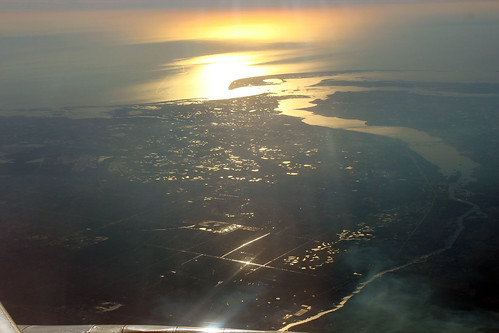
Friday, January 13th, 2012... the Air Cubana plane was almost on time, departing before 09:00 pm. Some of the Canadian tourists decided to start their Cuban vacation on the plane and soon became quite drunk and even rowdy—I was sorry for those passengers who had to sit close the them, they were visibly upset by their loud swearing. Some people said that Cuban planes were not allowed to fly over the US territory, but it was not true, they could and if there was an emergency, they could land on the US soil. As I was walking in the aisle to my seat, I noticed a stack of newspapers in the overhead compartment—it was the English edition of the weekly newspaper Granma. While in Cuba, it was not that easy to get even the Spanish edition of Granma (published daily), let alone the English one.
As we were circling around Cienfuegos, I could clearly see the bay (Bahia de Cienfuegos), the peninsula of Punta Gorda and the Jagua Hotel! We landed at Cienfuegos just after midnight—it was so nice to emerge from the plane into a warm, humid weather. We went very quickly through the customs. At the airport in Toronto I had bought “The New York Times” which was prominently sticking out from my carry-on luggage.
“Can I see it?”, one of the custom officers asked me.
I thought that maybe he wanted to quickly read it, but he was acting in his official capacity: he flipped several pages, looked at the date and called somebody on his radio; luckily, the reply must have been positive as he let me keep it. I do not think there was one tiny article about Cuba in this issue.
There were several coaches waiting in front of the airport.
“Which one goes to the Jagua Hotel?”, we asked.
“Go to that one”, somebody pointed towards a bus at the very end of the parking lot.
The driver showed up and put our baggage on the bus. We were the only ones onboard, but gradually more and more tourists came. All the other buses left, but ours was still waiting. We even saw our plane take off for Havana, yet we were still waiting for something or somebody. A few fellow tourists, originally from Croatia, were sitting next to us; they said that their luggage must have been put on the wrong plane and it was missing, even though the whole plane had just been searched. No wonder they were quite upset. Eventually a tourist showed up, got on the bus and we were finally ready to go.
“It’s not my fault”, he said apologetically, “I almost got arrested”.
I never found out what happened, but all of us were glad we were on our way.
Most of the tourists—as a matter of fact, all of them except for us—were heading to the Rancho Luna and Faro Luna (located on the beach), we were the only ones staying in the Jagua Hotel and it was where the bus went first. It was almost 2:00 am, yet we saw quite a few people in the streets (it was Saturday) and soon we could admire Cienfuegos’ neoclassical architecture. We took the Malecon (Paseo del Prado, a.k.a. Calle 37), passed a beautiful white building (the Cienfuegos Yacht Club) and arrived at the hotel. The reception staff were quite surprised to see us at this time of the night. We asked for a room on the seventh floor, but none was available and we ended up getting a room on fifth floor, #502.
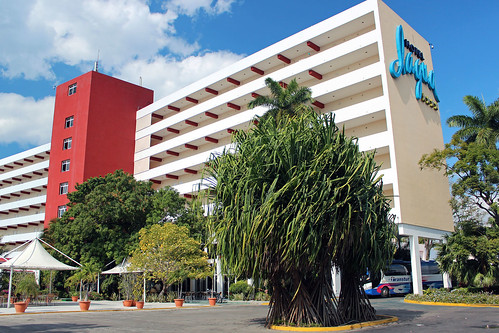
“Cinco?”, I asked.
“Si, cinco”, replied the receptionist.
The room was almost at the end of a long, open hallway. The magnetic card that was supposed to open the room door did not work; we kept inserting it different ways, but the door did not budge. After a few minutes of fruitless attempts we heard a voice coming from inside the room:
“You’ve got the wrong room number”.
We checked the document we got from the receptionist... and well, ours was number 402, on the fourth floor (yet we clearly heard “Cinco”). This time we had no problems opening the door. Once inside the room, we had to insert the card into a special device, enabling us to turn on the lights.
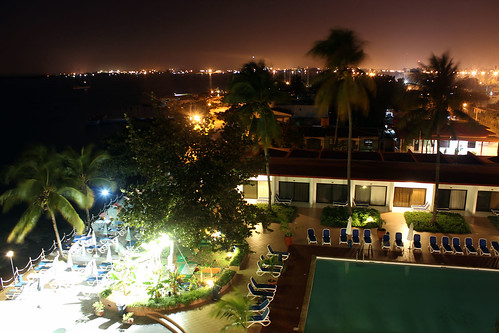
The room was quite pleasant—it had two beds, TV, telephone, a small fridge, air conditioning, bathroom—as well as a balcony where we could sit and see the hotel’s swimming pool, dock, Bay of Cienfuegos and the whole city; from the hallway we had had a wonderful view towards the south of Punta Gorda—a peninsula on Bay of Cienfuegos—as well as one of the most impressive buildings in the whole city, Palacio de Valle. On the other side of the bay protruded a huge dome of the never-completed nuclear power plant. I was terribly thirsty, so we went down to the bar (open 24 hours per day) and bought two cans of beer “Bucanero”. Usually the beer sells for 1 peso; we paid 6 pesos for 2 cans in the hotel bar—and it was our first and last visit in the bar. We were back in our room around 3:00 am and soon fell asleep.
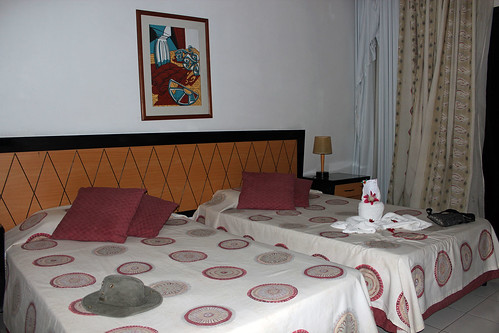
The Hotel Jagua was built just before the Cuban Revolution by president Batista’s brother. There were also plans to set up a casino in the adjacent Palacio de Valle (in fact, the Palacio’s garden used to be at the present site of the Jagua). Before the Cuban Revolution Punta Gorda was one of most expensive areas of Cienfuegos—to this day it has an undeniable charm, houses are well-kept and many rent rooms to tourists (casas particulares). Incidentally, according to a plaque in the hotel, Fidel Castro visited the hotel shortly after the Revolution:
„In this room on August 18, 1960 comrade Fidel Castro Ruiz talked about the vital importance of the Jagua Hotel for the development of tourism in the central region of the island”.

The hotel was very popular with various organized groups travelling across Cuba; almost all tourists spent just one or two nights there and moved on. That was why we could always see buses in front of the hotel, with tourists arriving and departing. As a matter of fact, we were the only hotel guests who stayed at the hotel for one full week—even Rien, our Canadian travel agent from http://www.tripcentral.ca/ , said he was not aware of any other travelers who booked this hotel for one week. Well, tourists who buy week-long packages to Cuba usually stay at all-inclusive resorts, close to the beach; on the other hand, Hotel Jagua was in Cienfuegos, about 3-4 kilometres from the city center. Only breakfast was included in the package price—no other meals, no ‘free’ drinks! Every morning we enjoyed excellent omelettes or eggs, fresh bread, salads and three kinds of enormously delicious cheese! Unfortunately, the coffee machine worked the “Cuban way”—sometimes I was getting black coffee and no milk, sometimes just milk and no coffee and I did not have one decent cup of coffee during the whole trip, but since I am not a big coffee drinker, it was not a big deal. Otherwise we liked the hotel—the elevators were working, there was hot water, the maid cleaned the room every morning, the fridge kept our food and beer cool, the staff spoke English and the location was ideal.

Across the street from the hotel (Calle 37) there were two restaurants which offered the same beer that could be bought in the hotel, but for a fraction of the price (i.e., one peso vs. three pesos plus tips the hotel bar charged); in addition, there was a supermarket on the same street (about 600 meters north of the hotel, on the east side of the street, just past the gas station and north of Avenida 20) which had plenty of liquors and liqueurs, mineral water, beer, cheese and many other items. We went to that store a couple of times and bought several bottles of mineral water and plenty of beer. It was also possible to do some shopping at the smaller store at the back of the gas station and sit at the table outside.
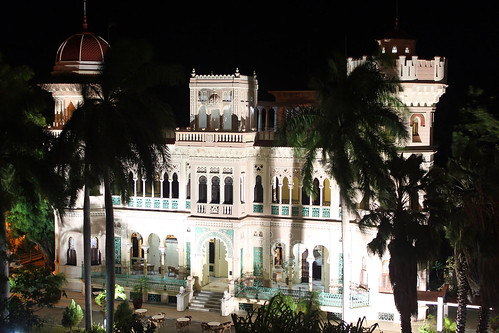
Even though we did not sleep much, on Saturday, January 14, 2012 we were up early, had breakfast and then walked across the hotel’s parking lot to the Palacio de Valle which we could see every day from the hotel’s hallway. It was indeed a remarkable building! Built in 1917 by Don Acisclo del Valle with a mixture of architectural styles, it had ornate walls, ceilings, stairs and many other decorations. In fact, the hotel was built on what used to be the Palacio’s garden. As we entered, we saw an older Cuban lady, wearing very distinct and colourful clothes and had, playing the piano.
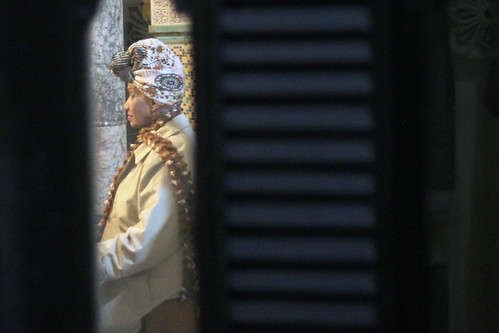
Of course, it was Carmen Iznaga, who for many years had been a fixture at this place! I really liked the way she played the piano and sang; after a few minutes she got up, went up to Catherine and showed her a bunch of CDs with her music. We bought one disk which she kissed, leaving an imprint of her lipstick! I am really glad we bought it—it was a very special kind of music. After taking a few photographs with her, we continued walking on Calle 35 towards the end of the peninsula. The houses were quite pretty, there were a few immaculately spotless American antique cars from the 1950s and I took a lot of photos. I was told by one local resident that during hurricanes the peninsula was battered by the wind and waves; if I understood him correctly, he said that sometimes the water was everywhere, flooding the homes.
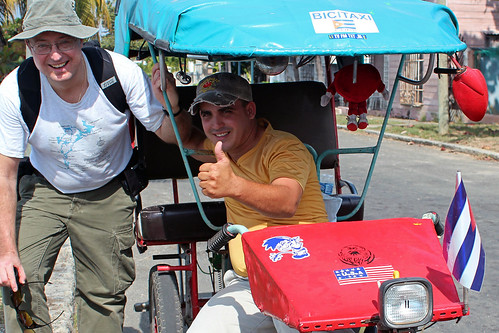
Just near the hotel, at the intersection of Avenida 0 and Calle 35, a bicycle taxi (bicitaxi, a.k.a. rickshaw) driver approached us and offered a ride. We were not interested in going anywhere at that time, but struck up a conversation with him—mostly in our super-basic Spanish, as he only knew a few English words. His name was Alain and he told us that it was his private bike and he had to obtain a license to operate it. He paid a certain amount to the government (in Convertible Pesos, or CUC) and also a percentage of his total earnings (although I never figured out how such amount was supposed to be determined—taxi drivers never issued any receipts). He was quite a nice fellow and we told him to be in front of the hotel at 5:00 pm—at that time we wanted to go to town. We went back to the hotel room and took a nap, getting up just before 5:00 pm.

As promised, Alain was waiting for us. He was not the only bicycle taxi driver—there were plenty of those bike taxis in front of the hotel, in addition to regular taxis. As we found out, all the drivers recently were permitted by the government—well, almost encouraged—to set up their own businesses. During my last visit in Cuba in November 2010, I had talked with some people about the recent Cuban government decision to lay off hundreds of thousands of government employees. Since the government could not provide them with employment, the only reasonable alternative was to encourage them to become self-employed—and thus a lot of people have taken advantage of this new opportunity, working ‘por cuenta propia’ (‘on their own account’).
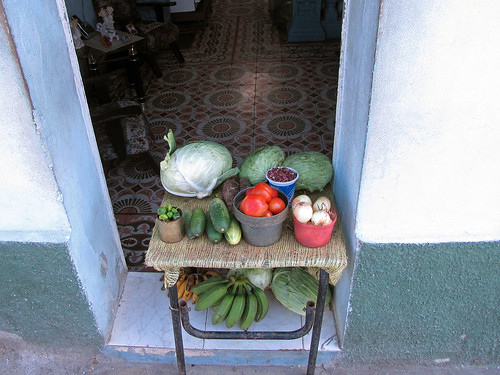
That new policy was evident everywhere—we saw a lot of private bike taxis, horse-drawn carriages, regular taxis, repair shops, speciality stores (many operated right out of buildings’ windows), vegetable and fruit stands—as well as a lot of people were offering to take us to newly opened private restaurants. They were not the infamous ‘jinteros’ or hustlers—they actually worked for those restaurants, often wore uniforms and gave us business cards. Invariably, we made use of this very helpful Spanish expression: “Acabamos de comer en el hotel” (we’ve just eaten in the hotel) and in most cases they left us alone. Welcome to Marketing 101, Cuban style! And we did see a lot of shops selling good quality western apparel, food items, appliances, home renovation equipment and many others things—meaning that at least some people did have money and could afford such articles. In a nutshell, this country was certainly changing for the better. If the changes continue, in several years it will be a very different country from what it is today.
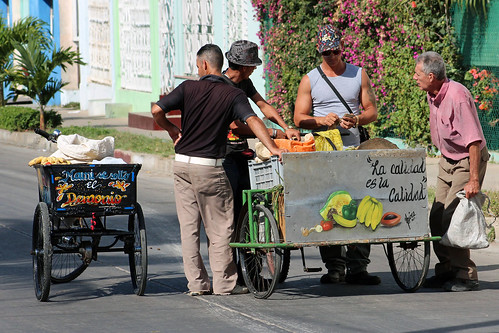
We came across a lot of other independent tourists from all over the world. Most of them were staying at Casas Particulares and many were travelling across Cuba in rental cars. Undoubtedly, it was a very convenient way to explore Cuba. I met a young gentleman from, I believe, Australia, who travelled with his wife by car and stayed in a Casa Particular.
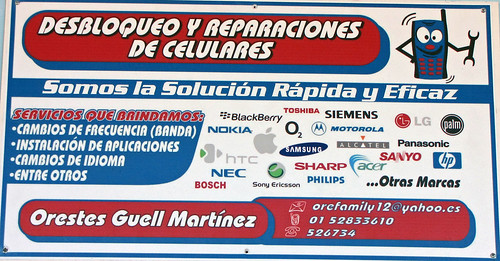
“I love Cuba”, he said. “People here are so happy and surprisingly well-off. The socialist system works quite well here.”
Then he went on telling us how well Cubans lived and that they had basically everything—the fridge, car, washing machine, nice house, cell phone, stereo equipment, modern TV sets... I was curious how he met those people.
“I’m talking about the family that owns the Casa Particular we stay at”, he said.
Well... when I am on vacation, I do not feel like engaging in any political arguments, but I was very eager to point out to him that the ‘well-off’ Cubans he was referring to were, for all intents and purposes, business people, ‘who made a living by converting part of their house into a small bed-and-breakfast style hotel. And whenever we saw the distinctive sign on the building indicating a casa particular, without fail such a house was very elegant, well-maintained, with a fresh coat of paint and had a lovely garden.
In other words... capitalism seemed to work in Cuba, even on a relatively such a micro scale! That is why I sincerely hope that the new rules will allow many Cubans to engage in various profitable activities and result in an rise in their overall standard of living. It is a given that there will be some inequality and ensuing problems—already the hiatus between self-employed Cubans, ‘cuentapropistas’, and the others is expanding—but hopefully the government will not stifle new businesses with excess taxation and over-regulation.

Alain took us along Paseo del Prado (Calle 37) to Avenida 54 (a.k.a. San Fernando). As we were approaching the intersection, we saw a gay man ostentatiously strolling along the boulevard. He triggered a lot of glances and smiles from almost everybody. Alain said that not long ago it had been illegal to be a homosexual in Cuba, but now was legal. Another sign of progress! We got off the rickshaw, paid him about 3 pesos and headed towards the main square.

Paseo del Prado, running accross the city to Punta Gorda in the south, is the longest street of this kind in Cuba. We were surrounded by very remarkable neoclassical buildings with colourful column. There was a bronze life-size statue of Benny Moré at that intersection; he looked as if he was taking a nonchalant stroll down the Prado. Benny Moré, who was one of the most famous Cuban singers, was born close to this town and Cienfuegos was always his beloved city. This evening and many other times during our stay in the city we spent a lot of time walking along the boulevard and observing Cuban life.
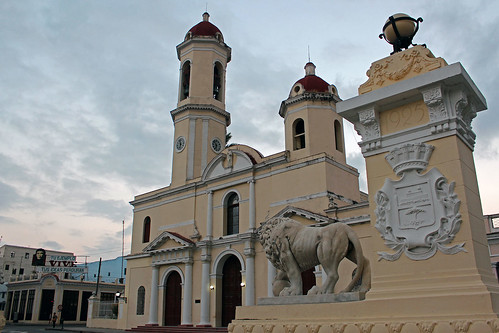
Leisurely, we were walking along Avenida 54 and reached Parque Jose Marti, with a statue of the ever present Jose Marti, an arch and a rotunda. The buildings around the square were probably the most beautiful buildings in Cienfuegos: La Catedral Purisma Conception, Colegio San Lorenzo, the Teatro Tomas Terry (where among others, Caruso, Bernhardt and Pavlova performed), the Palacio de Ferrer, with a beautiful tower on the corner (we did not climb it, though) and the most impressive building, the Antiguo Ayuntamiento: in the past it was town hall, now a provincial administarion building.
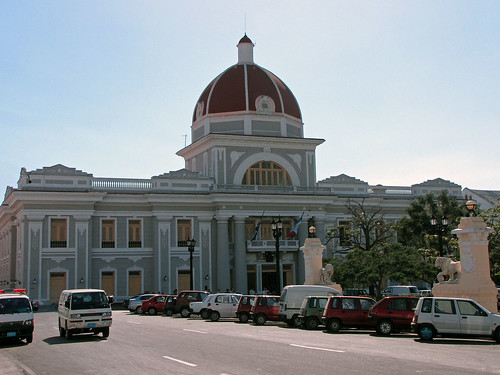
Before the trip I had found a photograph of Fidel Castro making a speech there on January 6, 1959, just when he was heading to Havana after the triumph of the Revolution; the speech lasted for several hours. Each building had such a rich history and probably it could take us the whole day to visit all of them, but since it was already getting dark, we just walked around and took photos. Over the next few days we would visit the square several times, often dropped off there by Alain (who, I should add, became our only bicycle taxi driver—each time we were leaving the hotel, he was already waiting for us, telepathically knowing that we were coming; near the end of our trip, we met his young wife and their child). That night, fascinated by the buildings and the city life, we walked along Paseo del Prado to our hotel and probably we were the only tourists doing so. I bought a few cans of beer along the way (“Bucanero”, 1 peso per can). Around Avenida 26 we saw a lot of young people congregating along the Malecon, there was a restaurant and probably a free dancing/concert. All this time we felt very safe—I had two cameras with me and a small camcorder—I do not think I would venture to walk like that in Toronto! We went to a small eatery and ordered a pizza; they were out of peppers and onions, but overall the pizza was good.
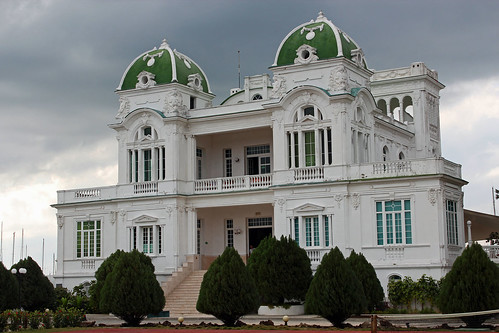
Just before reaching our hotel we passed by a very impressive, white building—it was Cienfuegos’ Yacht Club, built in 1920, with imposing twin domes. There were pre-revolutionary photographs in the main hall, showing the club members winning various sailing trophies. We went upstairs to take a look at a rather stylish restaurant; noisy music was coming from somewhere in the basement. The club was still used for sailing, there were a number of boats docked in front of it. We could see from our hotel window the club’s domes as well as a big sailing boat moored about 100 meters from the shore, it had a Swiss flag—from time to time we observed people going back and forth between the boat and the shore in a small dinghy.
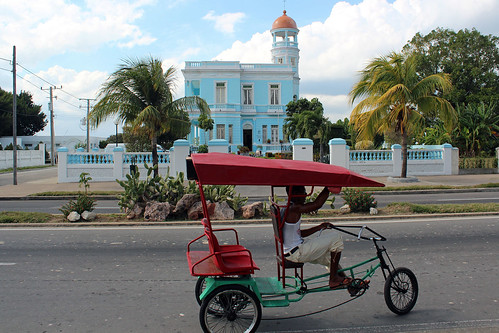
Although we did not use the hotel’s swimming pool, we were often sitting on the patio chairs near the dock, had a bottle of rum or liqueur and admired the sun setting on the other side of the bay. We were surprised to see a lot of tourists from the United States. They told us they were coming to Cuba legally, on special ‘educational’ or ‘religious’ tours and they visited, among others things, a variety of religious buildings and communities (the people we met were from Los Angeles, they were Jewish and they were going to visit synagogues and other places of worship). Of course, such tours were very expensive; when we told them how much we pay to come to Cuba from Canada (just over $600 per person), they were quite shocked!
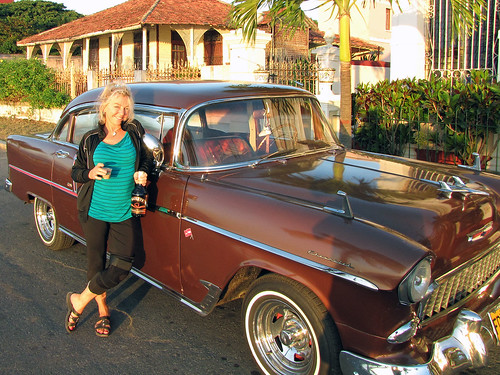
The part of Punta Gorda south of the hotel was also one of our frequent destinations. There were many casas particulares, bed-and-breakfast style private hotels, located in very well kept and tidy houses. We would often sit on the embankment, watching boats passing by and drinking rum. One evening Catherine dropped her sun glasses into the water, but she quickly found a way to descend into the bay, walked for several meters in the shallow water and picked them up. At the very end of Punta Gorda was a small parking lot and an entrance to the park, with a round patio on the very tip of Punta Gorda. Near the park’s entrance there was a house with a casa particular (Tony y Maylin) and a newly open, private restaurant called Villa Lagarto (Lizard) [Calle 35 #4B, e./Ave. 0 y Litoral, La Punta, Punta Gorda, villagarto_16@yahoo.com, tel. (53) (43) 519966]. A waiter standing in front of the house/restaurant was inviting us to come inside and have dinner. We spoke with him for a while—not long ago he had been a school teacher and now he had a new career, waitressing in this restaurant (as well as trying to get guests inside). His English was quite good and we told him that we would certainly come to this restaurant for dinner. By the way, the average monthly wage in Cuba is just below $20—yet those working in the private sector can make more in a day... that was why our next waiter, cook, rickshaw or taxi driver might not long ago have been a doctor, teacher or accountant! Indeed, later that evening we did have a very nice dinner there.
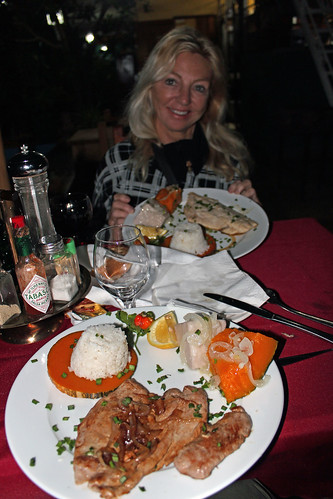
We were pleasantly surprised by this new establishment—it was very stylish, we were sitting next to a (swimming?) pool, the server was very professional, the food was very good and it was probably one of the highlights of our trip. The dinner cost 16 pesos each, plus red wine and tips—we paid almost 50 pesos, but it was certainly worth it.
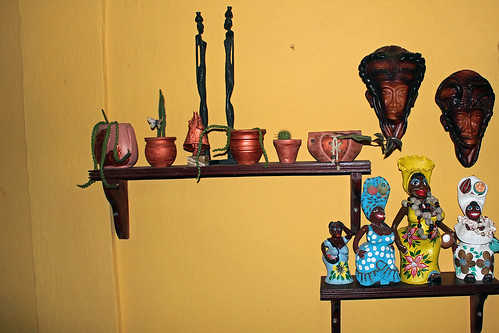
Over the next few days we made several trips to Cienfuegos, each time using Alain’s rickshaw services. For me, just walking along the streets and looking at the neoclassical buildings was a treat. I especially enjoyed snapping photos of buildings, old cars, people and kids in their distinct school uniforms. Unfortunately, many of the buildings were in bad shape, if not in ruins, ready to collapse at any time. As a matter of fact, while we were in Cienfuegos, a building in Havana did collapse, killing a number of its inhabitants.

We visited a catholic church, around Avenida 60 and Calle 41. There was a memorial plaque in the wall of the church in Spanish, which I tried to translate into English:
Fr. Regis Gerest, O.P. [Order of Preachers—Dominican], 1886-1941. Priest, educator. Orator and exemplary man. Association of Dominican Alumni. Nov. 28 1941.
We talked to the ladies inside and they were telling us something about the church, the adjacent building and Br. Regis Gerest. I could barely understand them, but I think this priest was responsible for founding or leading a Dominican school which used to be located in the adjoining building. I took a few photos and they gave us some pamphlets; it was a pity we were not able to attend a mass. They also told us about the Pope’s upcoming visit to Cuba, but he was not going to visit Cienfuegos. Later I found out that the Dominican order was restored in Cuba in 1898 and the same year the French Dominicans of Lyon established a mission in Cienfuegos. Realizing that the sugar industry, badly damaged in the war of 1895, was vital for the Cuban economy, they decided that it should also be reorganized and based on scientific basis. And so the Dominican Friar Regis Gerest helped starting first Sugar Chemistry courses in Cuba and personally developed teaching programs. In 1909 father Gerest founded the first School of Sugar Chemistry in Cuba and the Dominicans were able to provide it with the most modern and sophisticated equipment and French laboratories.
In fact, Cienfuegos was settled in 1819 by French immigrants and its original name was Ferdinand de Jagua, in honour of Ferdinand VII of Spain. That is why there are so many French influences in Cienfuegos; apart from its neoclassical architecture, it is even possible to see Cubans with distinct French features.

Cienfuegos had two cemeteries and we decided to visit one of them, Cementario la Reina, in the western part of the city, at the end of Avenida 50. On our way to the cemetery we saw a small outdoor railway museum with several old locomotives; old rusty train tracks were still visible, apparently not used for a very long time. At one time there must have been some kind of train repair shop—now it was converted into residences. We saw a lot of various tracks in Cienfuegos. According to an excellent website by Allen Morrison (http://www.tramz.com/cu/cf/cf.html ), Cienfuegos had its first streetcars in the early 1900s and the last tramway ran the tracks in 1954. But some of the tracks were certainly railway tracks, also abandoned long ago.
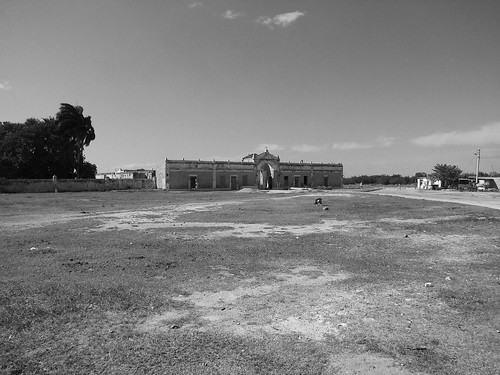
While walking along the street leading to the cemetery, we were invited to a Jehovah Witness temple for a conversation (and a possible conversion) and later stopped in a bar for a beer. There was a stray horse grazing on the grassland along the road. Passing horse buggies were crammed with Cubans and we did not see any other tourists. There was a deserted, open field in front of the cemetery, setting it apart from all the other buildings and making it look quite desolate. The cemetery was founded in 1837 and contained tombs of soldiers from the War of Independence. Some of the marble statues were very fine-looking; one of the statues, called Bella Durmiente, honoured a young woman who died over 100 years ago of a broken heart.

Apparently it is the only cemetery in Cuba where bodies were interred above ground due to the high groundwater levels (it is located close to the bay). Some of the tombs had caved in and were full of water, yet there were signs of restoration taking place.
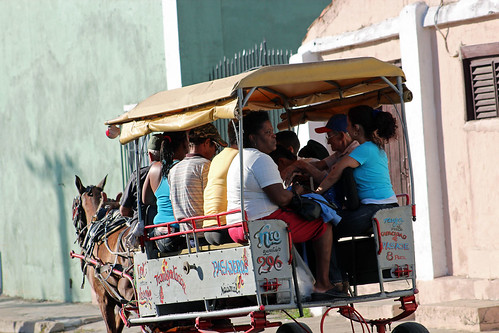
On our way to the cemetery (and basically whenever we were walking), a lot of bike taxis and horse-drawn ‘taxis’ passed us by and almost each time the drivers offered us their services; invariably we would say, ‘Gracias, pero preferimos caminar” (thanks, but we prefer to walk). Nevertheless one horse-drawn cab driver must have spotted us entering the cemetery and he was waiting in front of the gate, hoping that we would decide to hire his cab. He guessed correctly—we were much to tired to walk anymore and rode back to the hotel in his cab. Since horse cabs were not allowed on the main street, he took Calle 39, adjacent to Paseo del Prado and we had to walk the last 200 meters to the hotel.
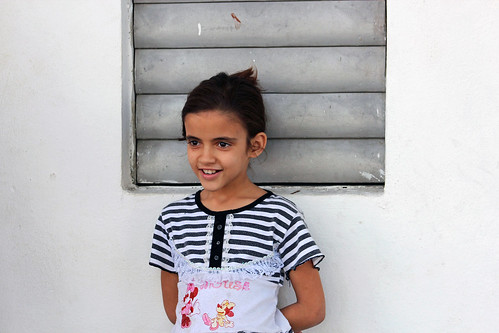
In the 1990s after the collapse of the Soviet Union and the cessation of its subsidies, the island was hit with severe economic problems and there were shortages basically everything—between 1989 and 1993 the Cuban economy shrank by 35%. During this “Special Period” (El Periodo Especial) Cuba was forced to adapt a number of austerity measures to keep the economy alive, albeit barely, and literally prevent people from starvation (it is estimated that on average each Cuban lost 22 lb over that period due to reduced calorie intake and increased physical activity). A few years ago we met a hotel worker who told us about her experience at that time.
“I was a student and normally I was supposed to commute to and from school daily. But there were very few working buses or trucks on the roads and very often there was not gasoline available. That’s why we had to live in the school for several weeks at a time and only occasionally going home for a visit. It was very difficult to get enough food, there were blackouts, we did not have school supplies, many things broke down and could not be fixed.”
As she was telling us this story, I saw tears in her eyes...
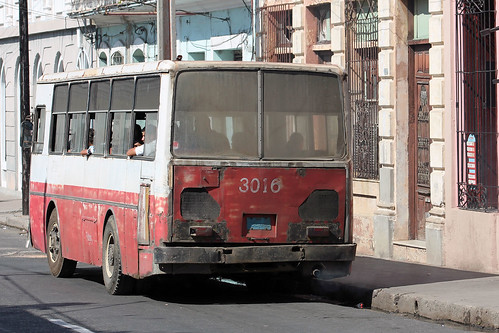
Transportation became one of many problems facing this country. In order to alleviate this situation, the government introduced a very peculiar contraption, a homemade double-humped ‘bus’, made of two shells welded together and pulled by a tractor-trailer. The ‘camello’, as it was called by Cubans, was a common sight on Cuba’s streets for many years after the fall of the Soviet Union. It was quite ugly and when crammed with hundreds of people—and usually it was packed—was like a hot oven, as well as a made a perfect setting for molesters and thieves. Besides, the tractor-trailers hauling this contrivance were not designed for frequent stops and constant city driving; as a result, they often overheated or broke down.
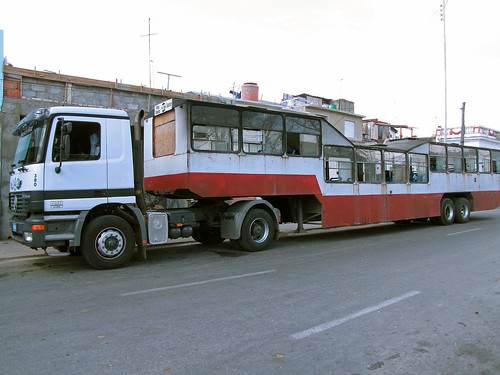
When I went to Cuba for the fist time in January, 2008, I only saw one camello near Matanzas, while going from the Varadero Airport to Havana; there were none to be seen in on the streets of the capital. I asked a few Cubans what had happened to the camellos.
“They’re gone”, they said, visibly relieved.
“You didn’t like them?”, I asked them jokingly.
They only rolled their eyes.
I found out later that in 2007 the government decided to phase them out and replace them with new Chinese made Yutong buses. Indeed, the name ‘Yutong’ could be seen on many buses in service in Cuba, whereas it seemed that the camello had become a thing of the past. So you can only imagine my surprise when I did see the famous camel bus in Cienfuegos, in Parque Villuendas, parked on Calle 41! I spoke to the driver and almost got a ride inside the driver’s cab...

Even though very few Cubans that we met knew any English, all of them were very nice, polite and helpful. Some of them invited us inside their modest dwellings and showed us photo albums—many of those photos had been taken by and with tourists (some of them Canadian) whom they had met. We were lucky to run into one gentleman who was an English teacher and we spent about one hour inside his house talking about tourism, the Cuban economy, new changes and life in Cuba in general.

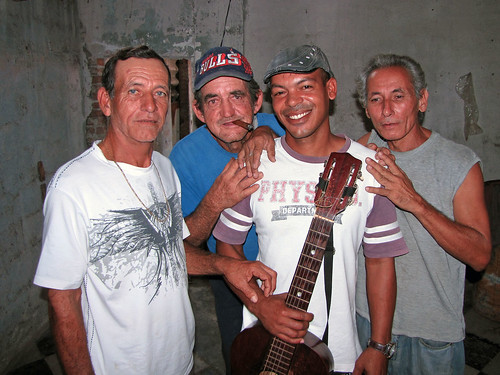
When we were walking by a terribly dilapidated building, whose roof must have collapsed long, long ago, an exposed brick wall caught my eye and I started taking photos. Somebody was inside and he immediately waved to me to come in; soon Catherine followed and we were inside his... well, dwelling: it was in a corner of a former hotel. The rest of the hotel was completely abandoned and looked as if it had been hit by a missile. In no time three of his friends showed up, one had a guitar and very soon he was playing the guitar and they were singing the famous Cuban song “Guantanamera”! I managed to immortalize this amazing performance on my video and have watched it several times since then.
The guitar player said he would be playing in a band at a restaurant located at Parque Jose Marti, at the corner of San Fernando (Avenida 54) and San Luis (Calle 27). An hour later we went there and spent over 30 minutes, drinking beer and listening to the performance by him and his other friends. I took a bunch of photos of them and promised to mail them in a couple of months.
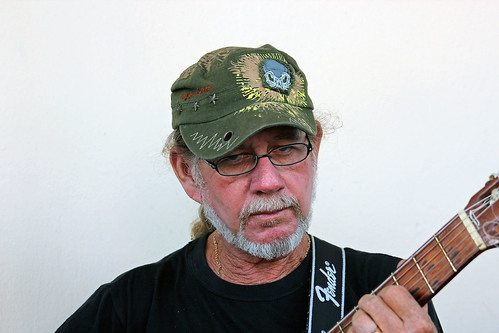
Once I saw a beautiful, immaculate old American car and started taking photos. The driver was more than happy to show me the inside of the car—apparently the car had a new engine, power windows and plenty of new equipment.
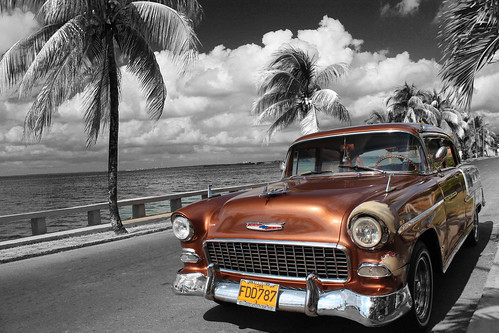
“My grandfather bought it before the Revolution”, he said, “Then he gave it to my father and my father gave it to me”.
“And you will give it to your kids”, I said.
Smiling, he replied, “Si!”
Only in Cuba!

I always liked photographing propaganda posters and other signs pertaining to the Revolution. On September 5, 1957 a rebellion against Batista took place; as a result, the city was bombed and many people died—we saw plaques and other memorials commemorating those events. Here and there we could spot a big poster of Che Guevara, Fidel Castro, Raul Castro and other revolutionaries.

Usually I did not talk about politics, but once I asked a Cuban about Fidel Castro: is he in hospital?
“Yes”, he said, “he’s quite old and infirm now”.
“I know he still writes a column in Granma [the official newspaper of the Central Committee of the Cuban Communist Party] called Reflexiones de Fidel”, I said.
He looked at me and smiled.
“Yeah, Fidel is an old man... you know... he talks and talks... always socialismo.... blah, blah, blah... socialismo... blah, blah blah... socialismo.... blah blah, blah.... socialismo...”
That was the only discussion I had with Cubans about Fidel and politics.
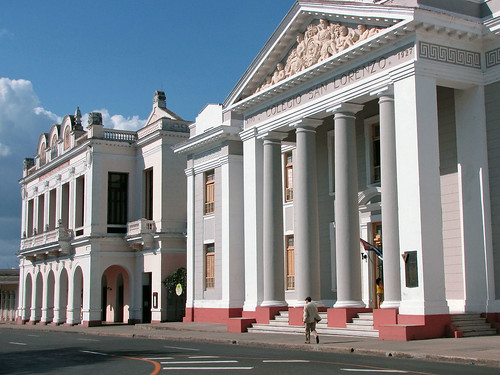
Since Cienfuegos lies on the shores of a large bay which is connected with the ocean through a channel, there used to be a fortress at the mouth of the bay, the Castillo de Jagua. It was built by king Philip V of Spain in the 1740s. From that excellent vantage point it was possible to defend the bay from pirates and keep all passing ships in check. We knew that a ferry ran from Cienfuegos to the Jagua Fortress a few times a day, but nobody could provide us specific information, except that it departed ‘sometime around noon’. So, we went to the ferry terminal and yes, it was departing at, I think, 1:00 pm and leaving the Fortress at 3:00 pm, thus giving jus just one hour for sightseeing. Because the departure would not be for a few hours, we just wondered around the streets. We got to a fire station, met several firemen and took photos—they let Catherine wear their helmet!

When we did come to the ferry dock, the place was swarming with people, over 99% of them Cubans. Fortunately, we got on the ferry—it was crowded, people were sitting everywhere and we ended up standing on the bottom deck. The trip took almost one hour—we passed close to our hotel (in fact, sometimes we had seen the ferry from our hotel), could see the distinct Punta Gorda peninsula and then were crossing the vast waters of Bay of Cienfuegos. The ferry stopped twice, some passengers got off and finally it docked at Castillo de Jagua. Across the bay a big, Soviet-style hotel (Islazul Hotel) spoiled the scenery. We walked up the narrow street to the Jagua Fortress.
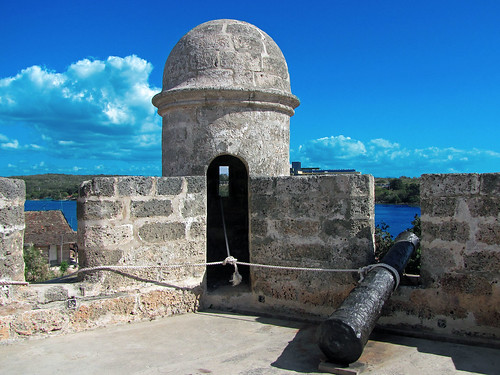
There were two big cannons in front of the castle as well as a real moat (sans water). Inside we saw an old prison cell; then we climbed the spiral stairs and reached the top. We saw the bay, ocean, city of Cienfuegos as well as the big dome of the Juranga Nuclear Power Plant (which was also visible from the hotel). In the early 1980s Cuba, with the cooperation of the Soviet Union, started building this nuclear plant. In the early 1990s the Soviet Union collapsed and the construction ceased. Later there were some further attempts to complete it with a cooperation of other countries, including Russia, but apparently the cost became prohibitive. Moreover, there was a lot of opposition from the United States due to potential safety issues and at the end the Cuban government decided to abandon the whole project. Since no nuclear material had ever been placed there, at least this white elephant did not pose any radiation danger. By the way, a few years back we met a hotel employee who used to study Nuclear Science in Bulgaria, but later found out that his profession was rather superfluous.

It was very hot and I bought a couple of cans of beer in a nearby store and then we went back to the dock. I was watching a colourful eel and so-called ‘pen-fish’, very long and thin. The lady living in a house next to the ferry terminal had cages with guinea pigs. This time the ferry was quite empty; on the spur of the moment Catherine decided to get on the ferry’s bow and I followed her at the last second. It was an excellent idea—we ended up on the bridge and once the ferry was on the open water, the captain—a very charming, dark-skinned gentleman who had been working on the ferry for over 30 years—allowed us to go into the wheelhouse and even steer the ferry! We had a lot of fun, talked to the crew and enjoyed the whole journey very much.
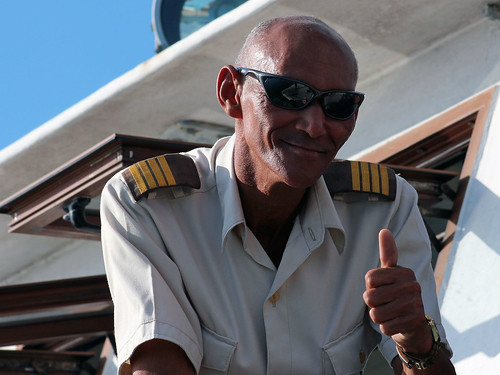
Since there is no beach in Cienfuegos, we (or, I should rather say, Catherine) wanted to spend some time on the beach. We knew there was a public beach between Hotel Rancho Luna and Hotel Faro Luna (called Playa Rancho Luna); this time we could not use Alain’s bicycle taxi (unless we were willing to squander the whole day riding the rickshaw and risk working him to death from exhaustion), yet he quickly called his friend who showed up in no time and took us to the beach. It was a very sunny, hot day and the beach was quite nice—there were both tourists and Cubans. Catherine walked to the Rancho Luna, but was not impressed by what she saw. We spent some time talking to a Cuban guy who worked on the beach, his English was quite OK. There were a number of stray dogs; one of them decided to lie down next to us. Using a stick, I was scratching his back and he loved it! Later we went to one of two restaurants on the beach, had two mojitos and returned home, this time using a regular taxi which turned out to be 4 pesos cheaper than Alain’s contact who had taken us there for 12 pesos.
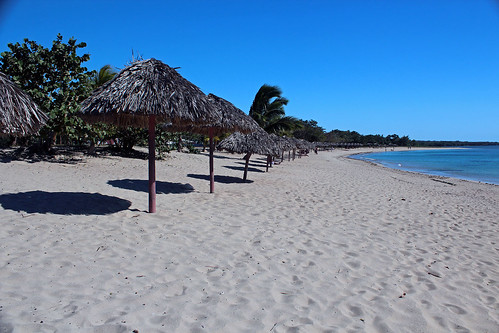
We went to the same beach again the day before our departure, just for a few hours (in the morning we extensively explored the city). I bought a few Cuban movies for 2 pesos and purchased a coconut. Later the guy who had sold me the coconut asked Catherine if he could use her towel to cover himself since he was cold. He was very pleasantly surprised when she said that he could keep the towel! Around 6:00 pm we observed the sunset and went to the other restaurant where Catherine had a quick dinner. This time we told the driver what time we would be leaving; he arrived at least one hour earlier—he did not want to lose business! Well, he made over 20 pesos that day—and I do not think his ‘taxi’ was licensed either.
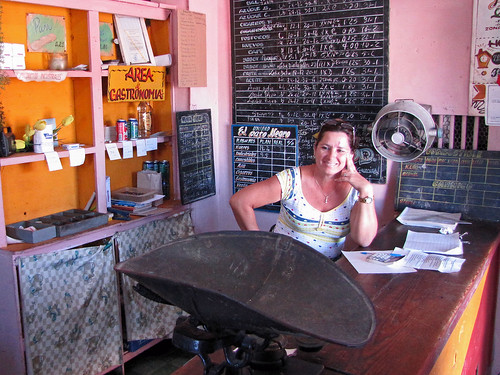
Before we knew, it was Friday, January 20, 2012 and our trip was coming to an end... On that day we were up very early, packed up and wanted to just take a walk in the streets around our hotel. As always, Alain was waiting for us, took us there and then waited for us in front of a government store at the corner of Avenida 34 and Calle 43. We walked around, met a few nice people, took photographs and gave away some of the remaining gifts.
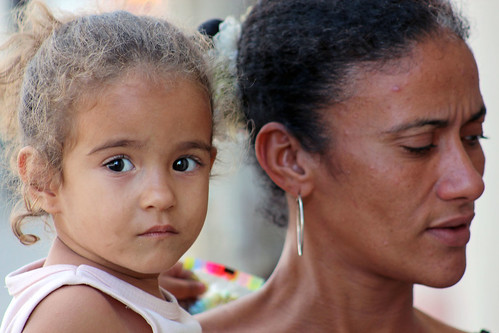

At the same time a government worker was going from house to house fumigating for mosquitos (Dengue Fever). It looked like one house was on fire, as smoke was pouring out from all sides but it turned out to be the powder dust used in the fumigation. I wonder to what extend this chemical us a health hazard in itself? Finally, we returned to Alain, who was waiting in front of the store. The store staff liked my stickers and asked for me; as a gift, they gave me.... an old ration card booklet ! Most Cubans still rely on the Libreta de Abastecimiento (Supplies Booklet) distribution system, introducted in 1962. It allows each person or family to buy various food products at special stores at subsidized prices. The libreta contains a page for every month and Cubans are required to present the libreta each time they buy the rations. Cetainly, it was a very original gift! Then Alain took us back to the hotel where we gave me the remaining gifts and say ‘goodbye’; he also gave us a Cubana magazine and a small Cuban flag, which had been attached to the front of his rickshaw.

The bus arrived around 1:00 pm—it had already picked up tourists from the Rancho Luna and Faro Rancho—and soon we arrived at the Cienfuegos Airport. I bought a few bottles of rum in the airport store. An hour later our Air Cubana plane, Airbus 310, landed (it was coming from Havana), let some passengers off and we went on board. I got another weekly edition of Granma (in English), but was too tired to read it on the plane. In less than 4 hours we arrived in Toronto, quickly passed through the customs and immigration and got into a limousine. The driver, originally from India, was a very nice and talkative chap and we had a very interesting conversation with him about his life, his job, India and Canada. We were very glad that there had hardly been any snowfall while we were gone—actually, it was one of the most ‘snow-less’ winters in history!
It was our fourth trip to Cuba. Whenever I am asked about my vacation in Cuba, I say that each and every trip was excellent and I can rate them between an “A” and an “A+”. This one deserved an “A+”!
Polish version of this blog/polska wersja: http://ontario-nature-polish.blogspot.ca/2012/02/cienfuegos-cuba.html
More photos: http://www.flickr.com/photos/jack_1962/sets/72157629906109508